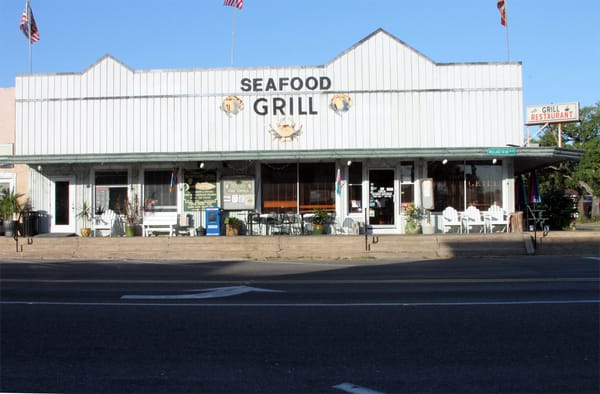Apalachicola
Apalachicola is a small town in the Florida panhandle, on Florida’s Gulf of Mexico coast.
Apalachicola is known for its interesting history, fresh seafood and pristine natural surroundings on the Apalachicola River.
Apalachicola is a nice day trip from Tallahassee, which is located approximately 75 miles to the northeast.
Apalachicola is a very small town, with a population of approximately 2,300 people. It’s a quiet place, but it’s also full of life, and is a fun destination for many visitors. I usually describe it as “Quaint, interesting and charming”.
Residents of Apalachicola tend to be friendly and are very proud of their city and history.
Apalachicola is named after the Apalachicola River. The river’s name is derived from local Native American language, referring to a meeting place where friendly gatherings might take place around a fire.
Visiting Apalachicola
Apalachicola is a different type of destination than most cities in Florida. It’s a popular travel destination for people who love nature and the outdoors, history and “Old Florida” culture. It’s especially popular for birdwatchers, photographers and people who appreciate history.
Most visitors say that two nights is a good amount of time to spend in Apalachicola.
Two nights are usually enough time to explore at a leisurely pace without running out of things to do.
Apalachicola is also a nice day trip from other cities in the region. Two large nearby cities include Tallahassee and Panama City Beach.
Location
Apalachicola is located in the Florida Panhandle, on the Gulf of Mexico. The city sits at the mouth of the Apalachicola River on Apalachicola Bay, which flows into the Gulf.
The location of Apalachicola gives convenient access to waterways, including the Apalachicola River and the Gulf of Mexico.
The town is located approximately 80 miles southwest of Tallahassee and 70 miles southeast of Panama City Beach.
Apalachicola is located in Franklin County, in the Big Bend region of Florida, which is largely rural and sparsely populated.
This area calls itself the “Forgotten Coast” due to lack of development and natural beauty.
Things to Do in Apalachicola and Nearby
Most things to do in Apalachicola revolve around water, nature and the outdoors. Popular activities include boating, fishing, water sports, camping, springs, and other outdoor activities.
There are a good number of things to do in Apalachicola and nearby.
Highlights of Apalachicola include:
Apalachicola Maritime Museum
Learn about local maritime history, including exhibits on boat building, marine ecology, and more.
Apalachicola National Estuarine Research Reserve
This large nature preserve protects wildlife and diverse ecosystems. It’s a popular place for hiking, birdwatching, wildlife viewing, guided tours and other outdoor activities.
Orman House Historic State Park
The antebellum (Pre-Civil War) home of a local cotton merchant, including beautiful gardens and views of the Apalachicola river.
St. George Island
A short drive from Apalachicola, a barrier island with beautiful beaches, fishing, and the St. George Island State Park, St. George Island Lighthouse Museum and more.
Apalachicola River
The Apalachicola River is a major source for local recreation. Most people visit the river for fishing, kayaking, boating, wildlife viewing and more.
John Gorrie Museum State Park
This is one of the smaller state parks in Florida – it features a museum dedicated to Dr. John Gorrie, a famous local resident.
Gorrie was a local doctor who invented refrigeration while living in Apalachicola in 1842.
His invention was used to create ice, which he used for air conditioning. Many call him the “Father of Air Conditioning”.
Gorrie’s invention was crucial for improving the lives of people living in hot climates, and allowing life to exist safely and comfortably in hot, humid places like Florida.
Prior to Gorrie’s invention the only source of ice came from northern climates, especially the Great Lakes. It seems crazy to imagine today, but blocks of ice were cut and packed into saw dust, which acted as an insulation. The ice was then shipped to the south.
Downtown Apalachicola
Downtown Apalachicola is a must-visit for anyone who loves to discover small towns in Florida.
Downtown Apalachicola is compact and easily walkable.The town was laid out in an old Spanish colonial design, with a large central square and several other smaller squares.
The town has a lovely, quiet, friendly and low-key atmosphere and the downtown has been beautifully restored.
The historic town has a quirky, local vibe. It’s mostly free of franchise restaurants and chains, which makes it feel unique. There are many hidden gems, including cute shops, good restaurants, and there’s often live music on weekends.
Historic Port Town
The town has a fascinating maritime heritage and an active, working waterfront.
Apalachicola was once the third largest port on the Gulf of Mexico, along with other port towns like Cedar Key and Key West.
Many of the town’s old seafront warehouses, commercial businesses, and homes have become galleries, restaurants, and boutiques. Some have informational plaques to describe their history.
The town has something like 900 historic buildings – many sites are on the national register of historic places.
Restaurants in Apalachicola
There are some delicious restaurants in Apalachicola and nearby. We love trying new places and always especially look forward to visiting The Station Raw Bar when we’re in town.
Some restaurants are in downtown Apalachicola itself. Others are across the Highway 98 bridge, and others are on St. George Island, across the Apalachicola Bay.

Here are some other restaurant options in and around Apalachicola:
- Apalachicola Seafood Grill
- The Owl Tap Room
- Owl Cafe
- The Station Raw Bar
- Up to No Good Tavern
- The Franklin Cafe
Apalachicola is known for its seafood, especially oysters. Apalachicola oysters are known for being some of the finest bay oysters in Florida, and have a distinctive briny taste.
The city has a long history of crabbing, fishing and oyster harvesting, which were once main staples of the local economy. Many local restaurants serve fresh seafood caught from local waters. Oysters are harvested daily by small open bay boats — they can usually be seen around Apalachicola Bay.
Hotels in Apalachicola
There are many types of accommodations available in Apalachicola and nearby.
Lodging options range from hotels and B&Bs to VRBOs, vacation rentals and campgrounds.
When we visit we usually come for a day trip, or stay in campgrounds. Here are some other options to consider:
- Gibson Inn
- Best Western Apalach Inn
- Water Street Hotel & Marina
- Coombs Inn and Suites
Events and Festivals
Apalachicola hosts several festivals and events throughout the year, including the Florida Seafood Festival, the Forgotten Coast en Plein Air art festival and others.
Living in Apalachicola
Living in Apalachicola can be idyllic, but it’s not for everybody. The lifestyle has pros and cons.
Compared to other coastal towns in Florida, Apalachicola has a relatively low cost of living.
Rural Relaxation
This region is one of the least-developed parts of Florida, due to a lack of major population centers nearby, geography, vulnerability to hurricanes and other factors. The population of Apalachicola was only 2,341 as of the 2020 Census.
Due to its small size, Apalachicola has limited shopping, dining, and entertainment options.
Economy
Historically, the main economic drivers in Apalachicola have traditionally been fishing, aquaculture, forestry and other similar industries.
Today tourism and vacation homes are its main sources of income. Many historic buildings have been restored and now serve as vacation rentals and VRBO listings.
Ecotourism has played an increasing role in the local economy in recent years, and is a major source of growth for the region.
Jobs in Apalachicola are limited and are concentrated in cyclical, low-paying industries, including hospitality, tourism and agriculture. Apalachicola is far from major cities, which limits job opportunities, access to airports, healthcare and other necessities.
Outdoors Oasis
Apalachicola has many opportunities for outdoor activities nearby, including fishing, boating, hiking, birdwatching and more.
Weather and Climate
Apalachicola experiences very hot and humid summers. This region of Florida is very vulnerable to hurricanes and flooding.
History of Apalachicola
Apalachicola has a fascinating history which goes back much further than most people realize.
Archaeological evidence shows that this region was inhabited for tens of thousands of years before the Spanish arrived in the 1500s.
Archeologists know that indigenous people lived in Apalachicola as early as 2000 BCE, including paleo Indians, Apalachee and Creek tribes, among others.
Many artifacts have been found, including shell middens and other evidence of civilization.
Archeologists say the area around Apalachicola was easily inhabitable due to its fresh water sources, which were scarce at the time. There were also large herds of wildlife which could be tracked and hunted.
In the early 1500s Spanish explorers came to the region. A military fort – the first European settlement – was built near the mouth of the Apalachicola River in 1705.
For the next centuries the area was ruled by various European powers. First the Spanish ruled, then the English, and then the Spanish again. Spain eventually gave control of Florida to the United States in 1821.
The most lively time for Apalachicola was in the mid-1800s, when Apalachicola played a part in the lucrative cotton trade. It was an important port for steamships which chugged up the Apalachicola river.
The town was once called Cottonton, when it served as a cotton trading post under British rule.
It was later incorporated as the town of West Point in 1828. The name was eventually changed to Apalachicola in 1831.
During the Civil War, the Apalachicola River was an important port and transportation hub for cotton and commodity exports. The Union navy eventually blockaded Apalachicola, along with other Confederate ports.
After the Civil War, Apalachicola turned towards other industries, including forestry, turpentine, oysters and natural sea sponges.
Greek immigrants came to the area and brought their knowledge of the sponge trade to the area. As late as the 1870s Apalichola was one of the leading sponge production locations in Florida, along with other coastal towns like Key West and Tarpon Springs.
The sponge industry eventually failed due to over harvesting and other factors. Sponges are no longer harvested in Apalachicola, but oysters remain a staple in the region.
Apalachicola Bay was once the source of 90% of the oysters in Florida. However, oyster beds have diminished due to pollution, water issues and other factors.
Over the years, the town’s economy has shifted towards fishing, tourism and ecotourism.
Final Thoughts
Apalachicola is a great small town in Florida. It’s a lovely place to visit for anyone who enjoys history, nature, seafood or “Old Florida” culture.
It’s also a great place to live for anyone who wants to embrace a slower pace of life in beautiful surroundings, and is willing to tolerate the downsides.
Apalachicola has a lot to offer – a strong sense of community and a relaxed way of life. It’s a little piece of old Florida, thriving right on the Gulf of Mexico.
